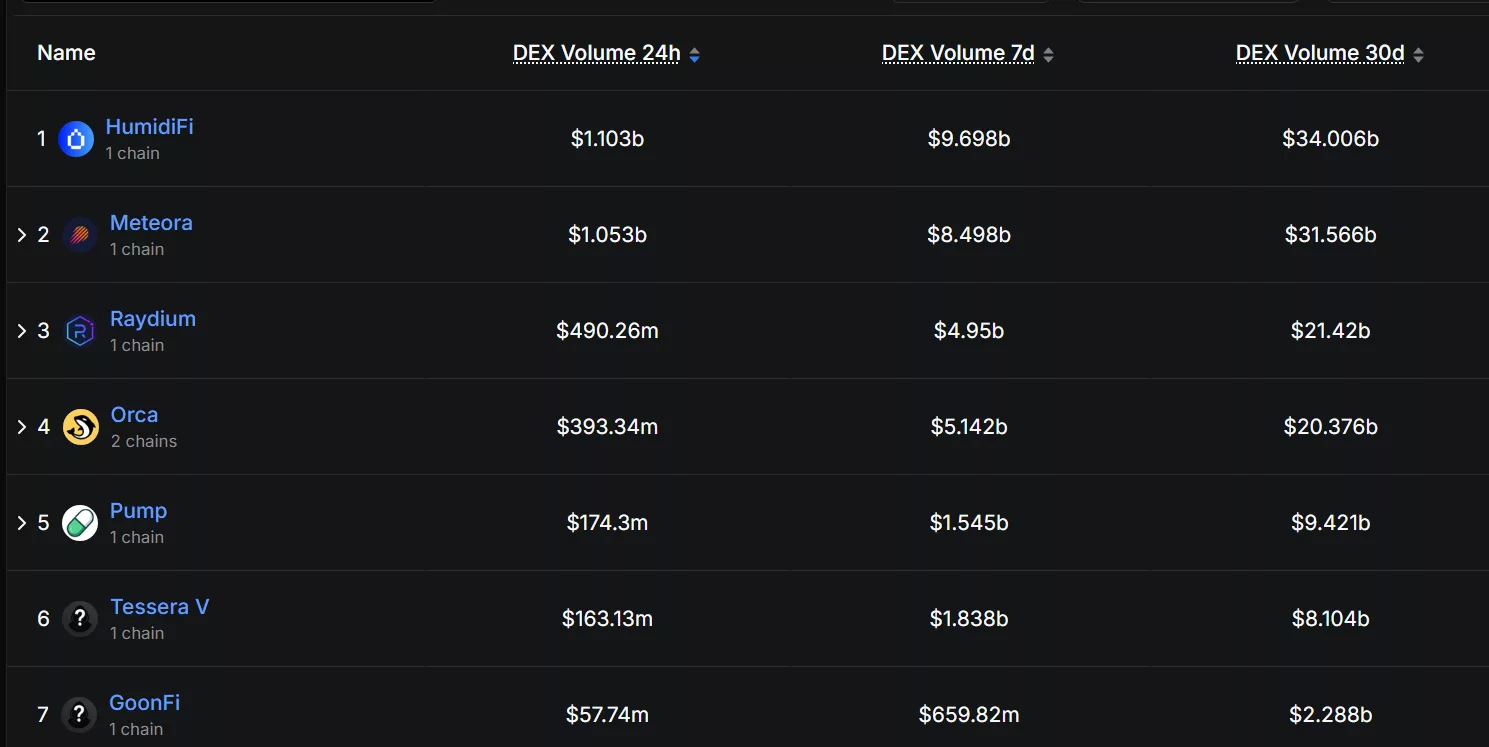Dark pool HumidiFi has become the largest DEX protocol on the Solana blockchain, surpassing Meteora, Raydium and Pump on all fronts.
Summary
- HumidiFi has overtaken major competitors such as Meteora, Raydium and Pump.fun to become Solana’s largest DEX, with a trading volume of over $1.1 billion per 24 hours.
- Its rise highlights a broader shift within DeFi toward dark pool or proprietary AMM models that prioritize execution efficiency and privacy over transparency and open liquidity.
On October 20, decentralized exchange HumidiFi, the dark pool, officially became the largest protocol on the Solana blockchain, after surpassing Meteora, Raydium and Pump.fun. According to data from DeFi Llama, the protocol contributes a whopping $1.1 billion to the total 24-hour DEX trading volume on Solana.
At the time of writing, total daily DEX volume on Solana (SOL) was over $3.68 billion. Compared to Meteora, the second largest DEX on Solana, the dark pool protocol only has a $100 million lead.
In terms of DEX trading volume in the last seven days, it also leads the way with trading volume reaching almost $10 billion. Meanwhile, Meteora’s seven-day trading volume is about $1.2 billion lower than the other protocol.
On the other hand, Raydium (RAY) daily DEX volume is approaching $500 million. Its seven-day trading volume is still below $5 billion, indicating that it is still halfway behind the two largest DEX platforms on Solana.

HumidiFi climbs to the top of the Solana DEX protocols on October 20 | Source: DeFi Lama
Meanwhile, Solana’s meme coin launch platform Pump.fun (PUMP) has fallen far out of favor. The protocol’s DEX trading volume is $174.3 million. Despite this, Pump.fun’s DEX trading volume stands at $1.5 billion, while its 30-day volume has reached $9.4 billion.
HumidiFi is a decentralized exchange platform built on the Solana blockchain that works using a ‘proprietary’ automated market maker or prop AMM, rather than the traditional open liquidity pool AMM model. This means that the protocol does not rely on external liquidity providers contributing to open pools, as many standard AMMs do. That is why it is known as a ‘dark pool’.
Dark pools keep transactions completely invisible to other users, unlike traditional exchanges. Protocols like HumidiFi allow traders to execute private traders, which is especially useful when executing high-value trades and large liquidations.
You might also like: CZ proposes building a ‘dark pool’ for DEX perpetual futures after James Wynn’s big loss
What does HumidiFi’s rise indicate?
The sudden surge in trading activity on HumidiFi could signal deeper changes within the decentralized finance industry. It signals a shift in the way liquidity is provided and consumed in DeFi.
Traditional DEX models, known for their open AMMs and public liquidity pools, are being challenged by models in which liquidity is centrally managed and trades are routed to highly efficient locations through aggregators like Jupiter. This could mean that the market shifts from public swimming pools to dark swimming pools.
Traders may prioritize execution efficiency and institutional-level trading mechanisms, rather than traditional metrics such as visible total value or open pool liquidity. HumidiFi claimed to have handled $8.55 billion in weekly trading volume while having a very low TVL as it emphasizes tight spreads, low slippage and reduced exposure to front-running or sandwich attacks.
On the other hand, HumidiFi’s increase in trading volume could mean that more traders are inclined to make their trades anonymous rather than public. The shift to closed liquidity models could very well raise concerns about transparency, decentralization and fairness in the chain.
Not only that, there is also the question of whether the model would be sustainable in the long term. It is possible that the increase in activity is only temporarily motivated by certain market conditions or pairs currently running on the platform.
You might also like: Zhao dark pool DEX could sink HyperLiquid, top trader says


